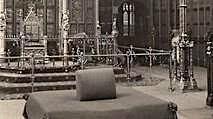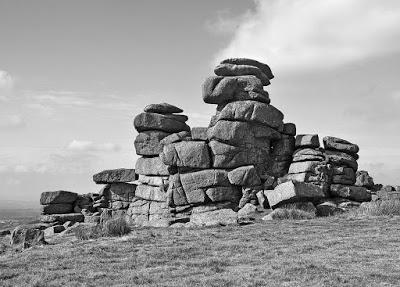 Baa baa black sheep,Have you any wool?Yes sir, yes sir,Three bags full.
Baa baa black sheep,Have you any wool?Yes sir, yes sir,Three bags full.
 One for my master,One for the king,One for the GeologistWho likes such things!
One for my master,One for the king,One for the GeologistWho likes such things!
Between Laramie and Cheyenne, Interstate 80 crosses the crest of the Laramie Mountains. But there are no rugged high peaks, no sparkling alpine lakes, no steep narrow canyons. Instead, the highway traverses a broad plain populated with peculiar rocks. They rise abruptly—like simple alters, or ancient castle walls, or stone creatures frozen on their way to stone temples. Travelers curious enough to stop will find they’re made of blocks: block walls, stacks of blocks, blocks scattered across the ground. The blocks themselves are distinctive. The rounded edges indicate they were born deep underground, where they were shaped by woolsack weathering. Only much later did they emerge into this world.

“granites rise in thick picturesque ridges, 50 to 100 feet high, like ruined walls, lending a peculiar as well as picturesque appearance to the landscape” wrote geologist FV Hayden of his visit to the Laramie Mountains in 1870. Photo by WH Jackson (USGS).
 Why "woolsacks"? … these rocks look more like wool bales. In fact, woolsack means bale in the case of rocks—specifically the bale of wool on which King Edward III (1327-1377) commanded his Lord Chancellor to sit while in council, in recognition of the importance of the wool trade. It became known as The Woolsack. Six centuries later it’s still in use, by the Lord Speaker in the House of Lords.
Why "woolsacks"? … these rocks look more like wool bales. In fact, woolsack means bale in the case of rocks—specifically the bale of wool on which King Edward III (1327-1377) commanded his Lord Chancellor to sit while in council, in recognition of the importance of the wool trade. It became known as The Woolsack. Six centuries later it’s still in use, by the Lord Speaker in the House of Lords.
Wool bales, 1900 (source).

The Woolsack, 1897 (source).
Woolsack weathering isn’t unusual, but the resulting forms are so fanciful that they grab our attention and spark our imaginations. Often they have evocative names and other-worldly explanations. We designate parks around them, for protection and public access.

The Cheesewring of Bodmin Moor, southwest England; John MacCulloch (1814).
The Cheesewring was named for its resemblance to slabs of cheese on a press. But legend says otherwise—it's a stack of rocks created in a contest between a Giant and a Saint. In spite of the great weight of the stones, the diminutive Saint built the taller stack (about 15 feet high), thereby avoiding death. The Giant was so impressed that he immediately converted to Christianity.
Vedauwoo Glen, in the Laramie Mountains, is home to Earthborn Spirits. It's managed by the US Forest Service.

The Great Staple Tor in Dartmoor National Park, a textbook case of woolsack weathering.
A stack or pile of woolsack rocks is often called a tor, possibly derived from the Old English torr—related to Scottish Gaelic tórr for a bulging hill—or possibly from the Celtic word twr meaning tower. Dartmoor National Park in southern England is famous for its legendary tors. There are at least 160, most with colorful names and stories.
Vixen Tor; John MacCulloch (1814).
Vixen Tor was home to the wicked witch Vixana. Whenever a traveler foolishly passed nearby, she called up a thick mist—so thick that the traveler lost his way, stumbled into a bog, and met an excruciating end, sucked screaming to his death. Vixana would dispel the mist just in time to enjoy the final moments of his desperate and hideous struggle. Finally Vixana herself was killed—by a handsome young moorman, of course!The tors of Dartmoor are legendary not just for tales and spirits, but also for pioneering studies by early geologists. In 1754, antiquarian, geologist and naturalist William Borlase concluded that Druids carved the tors, based on the prevalence of blocks. Druids were said to worship cubes, symbolic of the god Mercury—even though almost nothing was known about Druid culture then, as now.In 1814, Scottish geologist John MacCulloch read a paper before the Geological Society of London titled On the granite tors of Cornwall, in which he discounted Borlase’s theory. He didn’t mince words:“… learned antiquarians have tortured their inventions and have constructed religious systems for the purpose of explaining these very simple and intelligible natural appearances, by the rites of a mysterious and Druidical worship. … It is unnecessary to suppose that the chisel of Druidism has been employed to reduce it [the Cheesewring] to an image of Saturn. Natural causes are sufficient to account for its appearance.”The tors’ rounded blocks convinced MacCulloch that they had been shaped by air and water, not by human hands:
“The changes which they undergo in their places of rest, by their more rapid disintegration at the angles than at the sides, are sufficient to prove that this spheroidal shape may be produced by chemical action of air and water, without the necessity of any mechanical violence. However difficult it may be to give a very satisfactory account of this peculiarity, the fact is undoubted.”

Woolsack weathering—“more rapid disintegration at the angles than at the sides”
MacCulloch was only partly right. The rounded shapes were produced by chemical action of water but not air. That would be impossible, for woolsacks and tors form underground.

Woolsacks at Vedauwoo, Laramie Mountains. For origins, see diagram below.
Our local woolsacks are made of Sherman granite, which began as magma intruded into the crust about 1.4 billion years ago. It never reached the surface, but cooled underground into a huge mass of granite, shrinking and cracking in the process. Fractures often formed 90º angles—the beginnings of blocks. Groundwater percolated through the cracks, and chemicals broke down the rock, rounding the edges (spheroidal weathering).Then roughly 70-40 million years ago, during an episode of mountain-building (Laramide Orogeny), the Laramie Mountains rose, erosion set in, and the Sherman granite was gradually exposed. Weathered debris washed out of the fractures, and a multitude of wondrous rock forms emerged.

Birth and emergence of the woolsacks in the previous photo (click on image for details).
This land of science and the supernatural, where knowledge coexists with legend and whimsy, is just 15 miles from town. We're lucky to be able to wander among the real and the otherworldly as our mood sees fit.




Debris from weathered granite, called regolith or grüss.


The Potato Chip.

Prow of the Nautilus.

You name this one.

Watch out, Emmie ... it's ready to leap!

Unnamed stone creature, stone temple in the distance.

Woolsacks at sunset.

The witching hour. Click on image ... if you dare!
Sources (in addition to links in post)Borlase, W (Jackson, W). 1754. Observations on the Antiquities, Historical and Monumental, of the County of Cornwall. Available here.MacCulloch, J. 1814. On the granite tors of Cornwall. Trans. Geo. Soc. London Ser. 1 Vol. 2:66-78.
